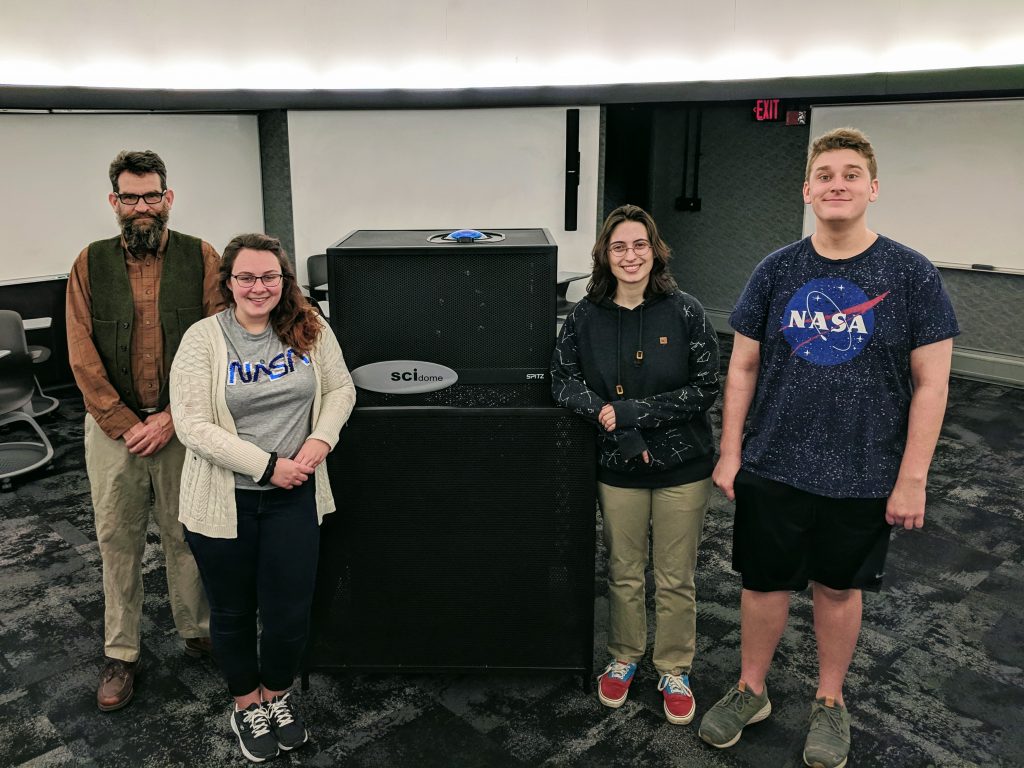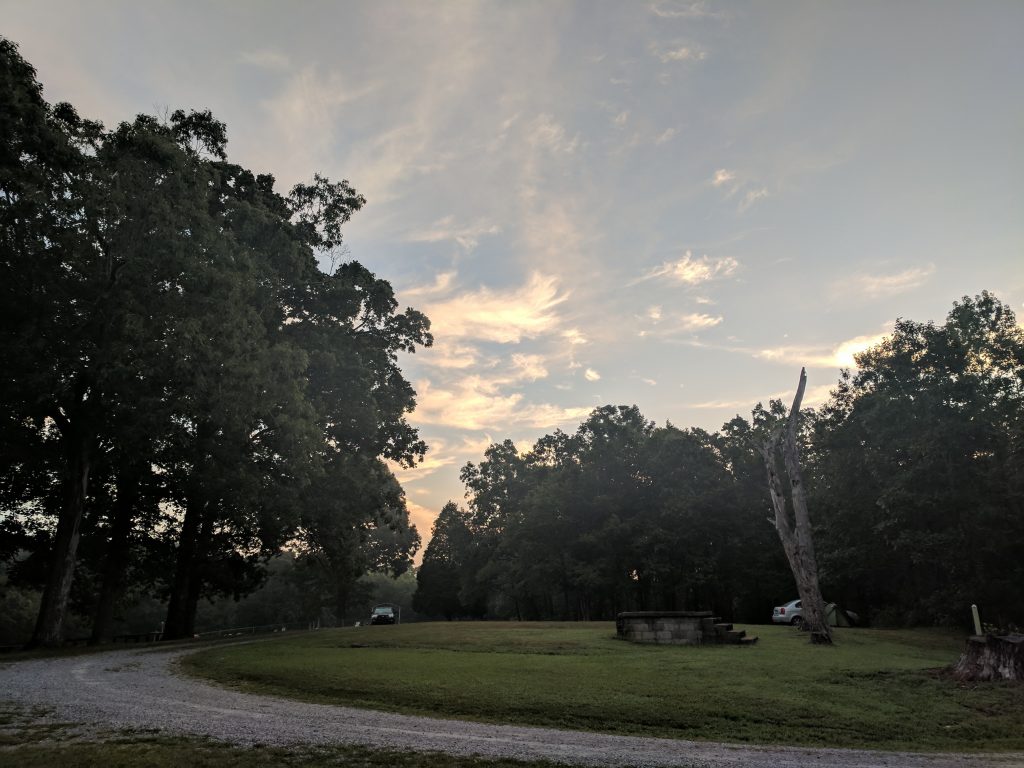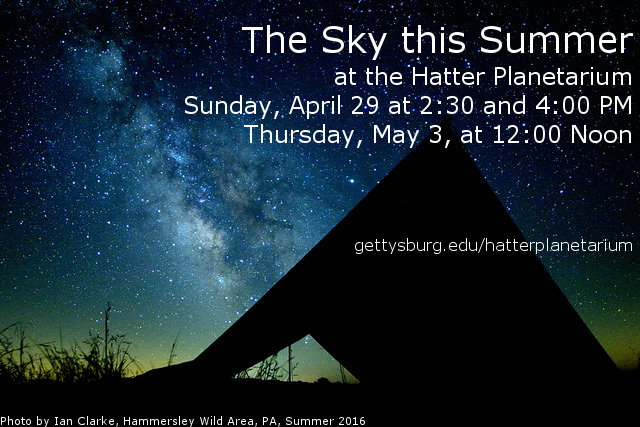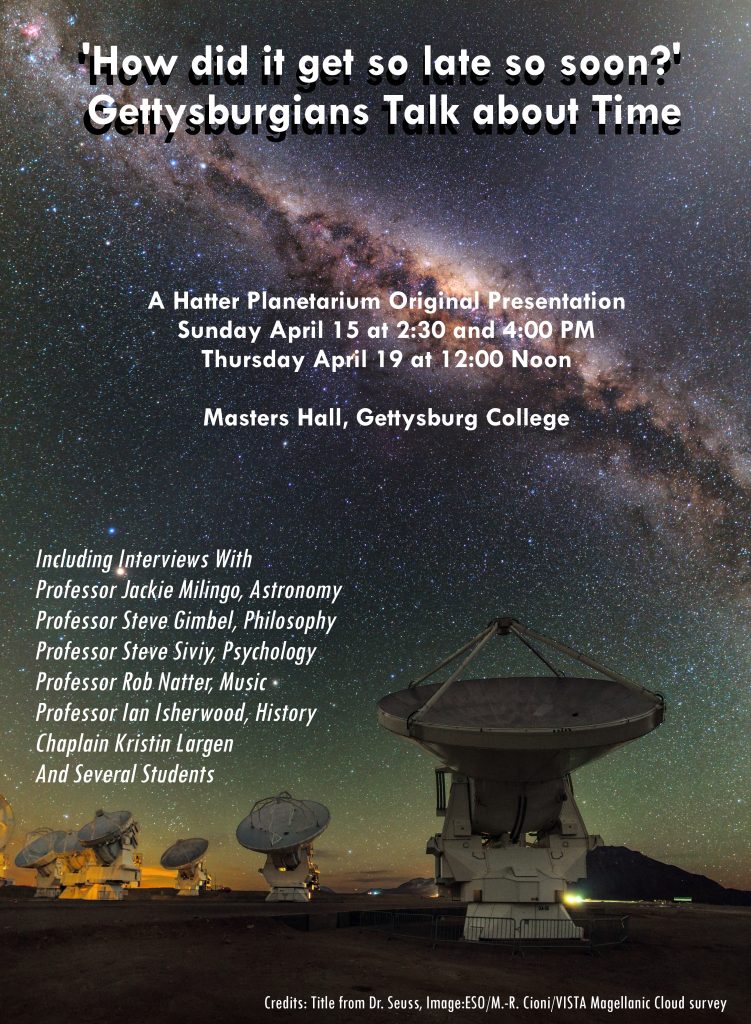
Our student assistants help develop, promote, and present our shows. We couldn’t do it without them.

Our student assistants help develop, promote, and present our shows. We couldn’t do it without them.

The Hatter Planetarium will resume our series of monthly sky talks on January 27 at 2:30 and 4:00 PM and January 31 at 12:00 noon. Visit our immersive, full-dome digital theater for a guided tour of the current night sky and a review of recent astronomy news. This month’s news will include a look at the recent Ultima Thule fly-by as well as some views of Sunday’s lunar eclipse. Sky highlights will include two bright planets in the morning sky.
This free program is a live presentation given by Hatter Planetarium director, Ian Clarke. The Hatter Planetarium is located on the first floor of Masters Hall. The show is free and the public is welcome. First-come, first-seated; the doors close when the show begins.

It’s time to announce our schedule of public shows for Spring 2019. The first show of the semester is “The Sky this Month” on January 27 and 31. All of our shows are free and open to the public and the campus community until seats are filled. Doors close when the show begins. Duration of the shows varies, but all are under an hour.
Following in the tradition of “Constellations across the Cultures” (2017) and “Gettysburgians Talk about Time” (2018), we are creating another in-house production this spring. The topic, chosen with our student assistants, will be the ethics of space exploration. The title is TBA, but it will debut on April 14. Watch this blog for updates as we work on it.
Scroll down for the full schedule. You can also download it as a PDF or access it via the college’s events calendar.
The Sky this Month
Immersive tour of the current sky, plus astronomy news and notes. General audience.
From Earth to the Universe
Good show for kids grade 4+ and their families.
The Sky this Month
‘How Did it Get so Late so Soon?’: Gettysburgians Talk about Time
Our own production from Spring 2018; featured in the winter alumni magazine.
The Sky this Month
Our Own New Production, Title TBA
Working topic is space ethics. Check the website/blog for updates!
The Sky this Summer
Sunday, September 30, at 2:30 and 4:00
Thursday, October 4, at 12:00 Noon
Visit our immersive, full-dome digital theater for a guided tour of the current night sky and a review of recent astronomy news. This free program is a live presentation given by Hatter Planetarium director, Ian Clarke. This month’s program will include the astronomical roots of Halloween and the hopping rovers of Hayabusa 2.
The Hatter Planetarium is located on the first floor of Masters Hall. The show is free and the public is welcome. First-come, first-seated; the doors close when the show begins.

Better late than never, my memories of eclipse 2017, including “Bear” the motorcycle astronomer and a mysteriously obedient black cat.
by Ian Clarke, Hatter Planetarium Director
A year ago–August 20, 2017– my wife and I packed up a car with water, power bars, sleeping bags, and extra eclipse glasses. We headed southeast from Pennsylvania toward the path of totality. On the way I read aloud that gold standard in eclipse writing, Annie Dillard’s essay “Total Eclipse.” After finishing I was forced to admit that, yes, perhaps the prose was just a bit redolent of the 1970s. Was there any chance that we’d really find ourselves screaming and then transported, speechless, to shadowed wheatfields on the banks of the Euphrates? In the late afternoon we set up camp in Western Kentucky. “Camp Umbra,” as I called it, was in a large clearing outside one of the many old cemeteries in the Land Between the Lakes National Recreation Area, remnants of the days before the TVA dams. We spent a restful night under a tarp, during which we were visited by absolutely no mosquitoes, midges, gnats, no-see-ums, or other arthropods (my wife seems to recall this a little differently).
Over the morning of Eclipse Day the unpublicized, off-the-grid clearing became a small community of a couple dozen shadow-seekers. At the center of it was “Bear,” a gregarious motorcyclist and amateur astronomer who had ridden down from Indianapolis with a tripod, spotting scope, and white projection screen strapped to his bike.
Just before 10:00 AM the disc of the moon began to slide across the face of the sun. We watched, using eclipse glasses, pinhole projection, and Bear’s scope as the eclipse progressed. Just after a quick lunch it surpassed the deepest partial eclipse my wife and I had ever seen. By then, any small opening–the spaces between leaves, a circle made with your fist–projected a shrinking crescent sun, or even many crescent suns if you looked under the right tree. The light was not so much dimming as it was being weirdly siphoned out of the landscape. Weirdly because it was so different from the clouds and sunsets that usually dim the light. Here there was hardly a cloud and the sun was high in the sky, nowhere near rising or setting. Shadows became impossibly sharp, and birds made roosting calls.
At ten minutes to totality a duct-taped Honda crunched gravel and parked outside the graveyard. A couple, probably in their twenties, got out. She announced that she had been looking forward to the eclipse for five years, but they brought no equipment. Bear motioned them to the spotting scope; someone produced two pairs of eclipse glasses. They were amazed and grateful. Behind them trotted a black cat, wearing a collar and dragging a green leash that was apparently completely redundant. It sat down at her feet.
“Once it goes total we can all look without glasses,” someone called out, though surely everyone in the clearing knew that. The cicadas, droning on all morning, suddenly stopped. “Oh listen,” said Bear. Then came the screams. Admittedly, they didn’t come from anyone in our group, but screams they were, from somewhere off to the west and just an instant before the moon’s shadow swept over us. Car horns and barking dogs too. Our staid gathering restricted themselves to “wooooo!” and mild blasphemies. Naturally the sky had gone dark; the sun was replaced by a tiny hole encompassed by the silvery diaphanous glow of the corona.
Here was another of Dillard’s many astute observations–the surprisingly small feature of the eclipse in an expanse of unearthly twilight. I have worked in a planetarium for over fifteen years, and I’ve presented about science and nature for years before that. I can tell you the apparent size of the sun and moon and that that size is smaller than the width of your pinky held at arm’s length. But the defining reality of a total solar eclipse is that it can’t be simulated, for what is required is the complete blocking of direct sunlight before it’s even hit the earth’s atmosphere. You have to experience that. For two minutes and 30.7 seconds we did. That’s a long time in eclipse-land: long enough for each person to look directly through Bear’s scope at the black nothing with its glowing halo. Long enough for each of us to exclaim whatever inadequate cliches offered themselves to mind. Long enough to be silent under the eclipse.
Then the cicadas came back, then “Baily’s Beads,” which are really light streaming through lunar valleys a quarter-million miles away. Then real sunlight. Not much sunlight, but here was another correct Dillard observation. A 99% solar eclipse, the event of a lifetime just a few minutes ago, was now old hat. By 85% most people had packed up their cars.  Bear was still there, but the young couple and their black cat had gone without my noticing. I was already thinking of April 8, 2024, in Erie County, Pennsylvania. Maybe they would be there.
Bear was still there, but the young couple and their black cat had gone without my noticing. I was already thinking of April 8, 2024, in Erie County, Pennsylvania. Maybe they would be there.
With a new academic year fast approaching, it’s time to announce our schedule of public shows for Fall 2018. All are free and open to the public and the campus community until seats are filled. Doors close when the show begins. Duration of the shows varies, but all are under an hour.
Scroll down for the full schedule. You can also download it as a PDF or access it via the college’s events calendar.
The Sky this Month (LIVE)
Oasis in Space (good for young elementary ages)
The Sky this Month (LIVE)
Constellations across the Cultures (Hatter Planetarium Original)
The Sky this Month (LIVE)
From Earth to the Universe
The Sky this Month (LIVE)
 This is your last chance to catch a public show until September! Lots to talk about, including two NASA missions, a snowstrom on a comet, as well as the summer stars and how to see them.
This is your last chance to catch a public show until September! Lots to talk about, including two NASA missions, a snowstrom on a comet, as well as the summer stars and how to see them.
The Sky this Summer
Sunday, April 29, at 2:30 and 4:00
Thursday, May 3, at 12:00 Noon
Free and open to the public; doors close when the show starts. The show will last about 45 minutes.
 The show is coming together and were getting pretty excited! “’How Did it Get so Late so Soon?’: Gettysburgians Talk about Time” is planetarium show about time, structured around recorded interviews with Gettysburg faculty whose work in some way touches on time (Professors Milingo, Gimbel, Natter, Isherwood, Siviy, and Chaplain Largen). There are some impromptu person-on-the-street quotes from students as well. Time is productive ground for a planetarium show because there really isn’t a rigorous definition that would function across disciplines in all situations. The show makes no attempt to formulate such a definition, just creatively presents the different ways some academics think and talk about time. In addition to the interviews the show will include some narrated explainers on such things as special relativity and timekeeping. There will be fulldome time-lapse video of campus. And some underwater fulldome video (really!).
The show is coming together and were getting pretty excited! “’How Did it Get so Late so Soon?’: Gettysburgians Talk about Time” is planetarium show about time, structured around recorded interviews with Gettysburg faculty whose work in some way touches on time (Professors Milingo, Gimbel, Natter, Isherwood, Siviy, and Chaplain Largen). There are some impromptu person-on-the-street quotes from students as well. Time is productive ground for a planetarium show because there really isn’t a rigorous definition that would function across disciplines in all situations. The show makes no attempt to formulate such a definition, just creatively presents the different ways some academics think and talk about time. In addition to the interviews the show will include some narrated explainers on such things as special relativity and timekeeping. There will be fulldome time-lapse video of campus. And some underwater fulldome video (really!).
 Like to think deep thoughts? Announcing our new, original, full-dome show for 2017-18! It’s an exploration of our understanding of time, based on interviews with Gettysburg faculty and students, with accompaniment and explanation facilitated by our immersive planetarium theater.
Like to think deep thoughts? Announcing our new, original, full-dome show for 2017-18! It’s an exploration of our understanding of time, based on interviews with Gettysburg faculty and students, with accompaniment and explanation facilitated by our immersive planetarium theater.
The Hatter Planetarium is located on the first floor of Masters Hall. The show is free, open to the public, and will run about 45 minutes. First-come, first-seated; the doors close when the show begins.The full Spring 2018 schedule can be found here.
“The Sky this Month” for April will be presented a bit early due to Easter weekend. Visit our immersive, full-dome digital theater for a guided tour of the current night sky and a review of recent astronomy news. This free program is a live presentation given by Hatter Planetarium director, Ian Clarke. The Hatter Planetarium is located on the first floor of Masters Hall. The show is free, open to the public, and runs about 40 minutes. First-come, first-seated; the doors close when the show begins.The full Spring 2018 schedule can be found here.